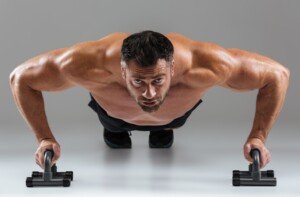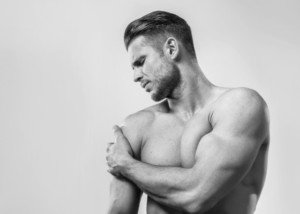
Can you do pushups with a rotator cuff injury?
Pushups are a real bear when you have a rotator cuff injury.
I have had rotator cuff problems in the past. And my clients — when I was a personal trainer — have had rotator cuff pain as well.
I strongly advise against doing standard pushups if you have a problem with your rotator cuff.
This article pertains to non-tear rotator cuff pain.
Doing standard pushups in the midst of a rotator cuff injury or pain will not make the problem go away.
It’s not something you can “work out.” Tendons need a lot of tender loving care to heal, and rotator cuff injuries or strains involve small tendons that don’t get much blood circulation; hence, why it takes so long for them to heal.
The pushup motion recruits activity from some of the rotator cuff tendons.

Freepik.com, drobotdean
Anybody with a problematic rotator cuff will tell you that pushups bring on the pain, aching or discomfort.
And if pushups aggravate your rotator cuff problem, I needn’t tell you that bench pressing won’t be any better.
In fact, any chest routine will aggravate this type of injury, with maybe the exception of pec deck motions.
Here is how I kept pushups in my routine, despite having rotator cuff pain (which has long since dissolved). I used the flat side of a BOSU board.

Shutterstock/sanneberg
I placed my hands on the rim of the board, so that my fingers were curled around to the other side, on the soft side, and with the lower part of my palm still on the flat or black portion.
This way, my palms were facing each other. My chest was already warmed up from light dumbbell presses.
Never just dive into pushups when you have unresolved shoulder issues. Be plenty warmed up first.
Initially I did the pushups off my knees; military style brought on some pain, and anything that aggravates these tendons will interfere with healing and possibly make the situation worse.
I could feel the tendon problem lightly knocking on my door while doing knee pushups off the BOSU board.
And this is okay; just a tapping on the door, as opposed to outright pain, is acceptable and won’t impede the healing process.
I did 2-3 sets of eight reps. Over time I increased reps to 12, keeping the pain just outside my door.
And then I began taking weight off my knees, so that eventually, I was doing military style pushups, but still using the BOSU board flat side.
When it no longer felt like work to do this, and when my shoulder felt completely at ease, I eliminated the BOSU board entirely.
This process may sound simple, but it occurred over several months.
“We call it graded exposure,” says Dr. Logan Thomas, a physical therapist in Parker City, IN.
“Anytime we perform an exercise, our muscles, tendons and ligaments are exposed to a certain level of stress.
“If our tissue capacity is greater than the stress placed on it, we feel no pain.
“If the stress level exceeds our tissue capacity, our body signals a pain experience which is a built-in defense mechanism. Pain gets us to stop.”
My pushups now include my feet being elevated, body in a straight line, without any hint whatsoever of rotator cuff strain.
I’m not recommending that you should try to reinstate conventional pushups before your rotator cuff injury is healed.
I say to wait until the issue is fully healed before reinstating this chest exercise.
Otherwise, you will need loads of patience to work pushups back into your regimen while your rotator cuff is healing.
 Dr. Thomas a physical therapist, and strength and conditioning coach who is passionate about patient education. He believes the most important and often overlooked step in the process to becoming pain-free is understanding the anatomy and biomechanics of your body.
Dr. Thomas a physical therapist, and strength and conditioning coach who is passionate about patient education. He believes the most important and often overlooked step in the process to becoming pain-free is understanding the anatomy and biomechanics of your body.
 Lorra Garrick is a former personal trainer certified through the American Council on Exercise. At Bally Total Fitness she trained women and men of all ages for fat loss, muscle building, fitness and improved health.
Lorra Garrick is a former personal trainer certified through the American Council on Exercise. At Bally Total Fitness she trained women and men of all ages for fat loss, muscle building, fitness and improved health.









































